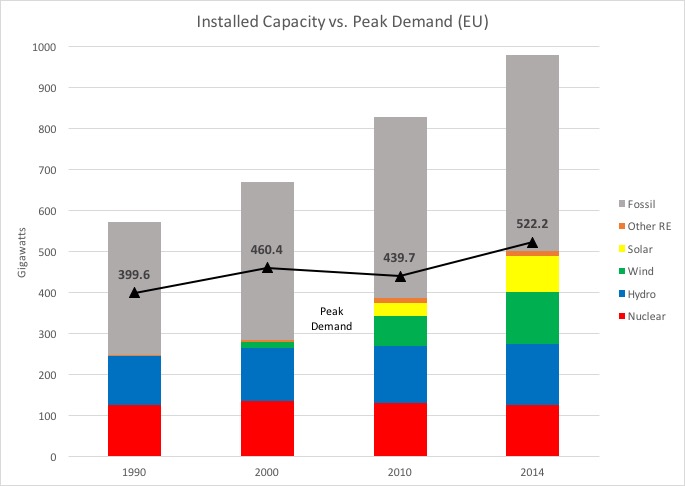The European Commission’s Market Design Initiative (MDI) rightly identifies investment and security of supply, demand-side participation in markets, and market governance as three central pillars of a successful market reform. In framing the initiative’s priorities, however, the Commission has neglected some of the most important obstacles to success in each of these three critical areas. Priorities for the Market Design Initiative: What’s Missing? What’s Most Important? summarizes these obstacles and offers practical steps toward meeting the EU’s climate and energy objectives in the most secure and cost-effective manner.
Investment and Security of Supply
The principal cause of the financial woes plaguing the power sector is not market design. It is rather a glut of old, inflexible baseload generation—primarily, but not exclusively coal-fired—that is surplus to requirements and incompatible with the power system’s growing need for more flexible resources.
The idea that we should “re-design” the power market springs in part from the perception that the market is failing to support investment needed “to keep the lights on.” On closer inspection, however, it becomes clear that this diagnosis misses the mark. With the exception of a few pockets isolated by inadequate transmission, Europe’s power sector is drowning under a glut of production capacity, and not just any production capacity.

The top priority in restoring a healthy investment climate to the power sector should be a targeted, “smart” programme for permanently retiring inflexible, old baseload plants as quickly as they become surplus to requirements. To support this, a new, regional, independent framework for assessing generation adequacy must be created—one that fairly accounts for all resources, including energy efficiency, demand response, storage, and interconnection. The paper also notes that this same issue of a saturated market for new capacity is one of several factors dictating that support for renewables investment must evolve and extend beyond 2020.
Demand-side Participation in Markets
“Empowering European consumers” is a rallying cry of the MDI and rightly so. Demand participation is not only essential for the market to work, it is a critical success factor for the energy transition. But the suggestions for action so far fall well short of what it will take to make this happen.
Getting price signals right is crucial, and the MDI can go much farther in challenging Member State interventions, such as capacity markets, that distort the information provided by energy market prices. If intervention to support investment is deemed necessary, it should first enhance rather than undercut the effectiveness of energy market prices. But better price signals are only a start:
- Wholesale and retail markets—and even in some cases national legislation—are rife with provisions that needlessly discriminate in favour of large generators.
- New entry by innovative players is inhibited by ineffective market monitoring and enforcement.
- Decarbonisation of the heat and transport sectors is expected to rely heavily on electrification, and yet the strategies for those new sources of electric demand are being developed without adequate coordination with power market strategies.
The paper presents a number of specific recommendations for addressing these problems and jump-starting demand’s role in markets, including time-of-use tariffs, especially for transport and heating and cooling applications, “smart appliance” standards, support for building grid-integrated thermal energy storage into heating and cooling applications, and limited supplier obligations.
Market Governance
No market design can succeed without effective governance. While the MDI refers to the need for a more regional and European approach to market governance, it overlooks the most glaring obstacle to success—the widely held and largely justified belief that the market is not competitive.
It would be foolish to expect any market design to succeed unless the conditions necessary for success are in place. From the wholesale to the retail level, consumers, regulators, and government must have confidence that they are not going to be exploited by a few large, incumbent generators and suppliers. Abuse of market power by established players can stifle the innovation and investment needed to overcome the challenges and seize the opportunities presented by the energy transition. Europe has yet to develop the kind of robust market monitoring, reporting, and enforcement framework that underpins successful electricity markets elsewhere in the world. The MDI must go farther in establishing an independent, expert, and fully resourced market monitoring and reporting function as well as clarifying and consolidating the competition enforcement regime. The paper also identifies a lack of coherence between energy and climate governance regimes and recommends that energy-related climate objectives be explicitly embedded into energy market governance principles.
Implementation, Governance, and Complementary Policies Critical to Success
The European Commission has opened an important window of opportunity to address critical electricity market-related issues. While there is a temptation to focus on the design of the current market as the problem to be addressed, in fact it is the galaxy of implementation issues, governance structure, and complementary policy challenges that require the most urgent attention. RAP presents a clear list of steps that can be taken within the current market framework that will:
- Restore a healthy investment climate and enable the transition to a more flexible system;
- Jump-start the all-important participation of demand and sustain its growth going forward; and
- Ensure the institutional structure for market governance is state-of-the-art and fit for the purpose.

